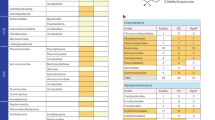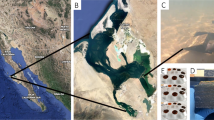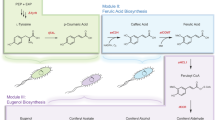Abstract
Molecular fossils of 2-methylhopanoids are prominent biomarkers in modern and ancient sediments that have been used as proxies for cyanobacteria and their main metabolism, oxygenic photosynthesis. However, substantial culture and genomic-based evidence now indicates that organisms other than cyanobacteria can make 2-methylhopanoids. Because few data directly address which organisms produce 2-methylhopanoids in the environment, we used metagenomic and clone library methods to determine the environmental diversity of hpnP, the gene encoding the C-2 hopanoid methylase. Here we show that hpnP copies from alphaproteobacteria and as yet uncultured organisms are found in diverse modern environments, including some modern habitats representative of those preserved in the rock record. In contrast, cyanobacterial hpnP genes are rarer and tend to be localized to specific habitats. To move beyond understanding the taxonomic distribution of environmental 2-methylhopanoid producers, we asked whether hpnP presence might track with particular variables. We found hpnP to be significantly correlated with organisms, metabolisms and environments known to support plant–microbe interactions (P-value<10−6); in addition, we observed diverse hpnP types in closely packed microbial communities from other environments, including stromatolites, hot springs and hypersaline microbial mats. The common features of these niches indicate that 2-methylhopanoids are enriched in sessile microbial communities inhabiting environments low in oxygen and fixed nitrogen with high osmolarity. Our results support the earlier conclusion that 2-methylhopanoids are not reliable biomarkers for cyanobacteria or any other taxonomic group, and raise the new hypothesis that, instead, they are indicators of a specific environmental niche.
Similar content being viewed by others
Log in or create a free account to read this content
Gain free access to this article, as well as selected content from this journal and more on nature.com
or
Accession codes
References
Biers EJ, Sun S, Howard EC . (2009). Prokaryotic genomes and diversity in surface ocean waters: interrogating the global ocean sampling metagenome. Appl Environ Microbiol 75: 2221–2229.
Brasier M, Green O, Lindsay J, Steele A . (2004). Earth’s oldest (approximately 3.5 Ga) fossils and the ‘early Eden hypothesis’: questioning the evidence. Orig Life Evol Biosph 34: 257–269.
Brasier M, Green OR, Jephcoat AP, Kleppe AK, Van Kranendonk MJ, Lindsay JF et al (2002). Questioning the evidence for Earth’s oldest fossils. Nature 416: 76–81.
Bravo J, Perzl M, Härtner T, Kannenberg EL, Rohmer M . (2001). Novel methylated triterpenoids of the gammacerane series from the nitrogen-fixing bacterium Bradyrhizobium japonicum USDA 110. Eur J Biochem 268: 1323–1331.
Brocks JJ, Logan GA, Buick R, Summons RE . (1999). Archean molecular fossils and the early rise of eukaryotes. Science 285: 1033–1036.
Brocks JJ, Pearson A . (2005). Building the biomarker tree of life. Rev Mineral Geochem 59: 233–258.
Caporaso JG, Kuczynski J, Stombaugh J, Bittinger K, Bushman FD, Costello EK et al (2010). QIIME allows analysis of high-throughput community sequencing data. Nat Methods 7: 335–336.
Clarke JT, Warnock RCM, Donoghue PCJ . (2011). Establishing a time-scale for plant evolution. New Phytol 192: 266–301.
Cooke MP, Talbot HM, Farrimond P . (2008). Bacterial populations recorded in bacteriohopanepolyol distributions in soils from Northern England. Org Geochem 39: 1347–1358.
Dupraz C, Visscher PT . (2005). Microbial lithification in marine stromatolites and hypersaline mats. Trends Microbiol 13: 429–438.
Etherington GJ, Dicks J, Roberts IN . (2005). Recombination Analysis Tool (RAT): a program for the high-throughput detection of recombination. Bioinformatics 21: 278–281.
Fischer WW, Summons RE, Pearson A . (2005). Targeted genomic detection of biosynthetic pathways: anaerobic production of hopanoid biomarkers by a common sedimentary microbe. Geobiology 3: 33–40.
Garby TJ, Walter MR, Larkum AW, Neilan BA . (2012). Diversity of cyanobacterial biomarker genes from the stromatolites of Shark Bay, Western Australia. Environ Microbiol 15: 1464–1475.
Gourion B, Rossignol M, Vorholt JA . (2006). A proteomic study of Methylobacterium extorquens reveals a response regulator essential for epiphytic growth. Proc Natl Acad Sci USA 103: 13186–13191.
Gourion B, Sulser S, Frunzke J, Francez-Charlot A, Stiefel P, Pessi G et al (2009). The PhyR-sigma(EcfG) signalling cascade is involved in stress response and symbiotic efficiency in Bradyrhizobium japonicum. Mol Microbiol 73: 291–305.
Guindon S, Dufayard J-F, Lefort V, Anisimova M, Hordijk W, Gascuel O . (2010). New algorithms and methods to estimate maximum-likelihood phylogenies: assessing the performance of PhyML 3.0. Syst Biol 59: 307–321.
Hoehler TM, Bebout BM, Des Marais DJ . (2001). The role of microbial mats in the production of reduced gases on the early Earth. Nature 412: 324–327.
Huang Y, Niu B, Gao Y, Fu L, Li W . (2010). CD-HIT Suite: a web server for clustering and comparing biological sequences. Bioinformatics 26: 680–682.
Hunt DE, David LA, Gevers D, Preheim SP, Alm EJ, Polz MF . (2008). Resource partitioning and sympatric differentiation among closely related bacterioplankton. Science 320: 1081–1085.
Katoh K, Toh H . (2008). Recent developments in the MAFFT multiple sequence alignment program. Brief Bioinform 9: 286–298.
Khamar HJ, Breathwaite EK, Prasse CE, Fraley ER, Secor CR, Chibane FL et al (2010). Multiple roles of soluble sugars in the establishment of Gunnera-Nostoc endosymbiosis. Plant Physiol 154: 1381–1389.
Knani M, Corpe WA, Rohmer M . (1994). Bacterial hopanoids from pink-pigmented facultative methylotrophs (PPFMs) and from green plant surfaces. Microbiology 140: 2755–2759.
Knoll AH, Summons RE, Waldbauer JR, Zumberge JE . (2007). The geological succession of primary producers in the oceans. In The Evolution of Primary Producers in the SeaFalkowski P, Knoll AH (ed) Academic Press: Boston, pp 133–164.
Kulkarni G, Wu C-H, Newman DK . (2013). The general stress response factor EcfG regulates expression of the C-2 hopanoid methylase HpnP in Rhodopseudomonas palustris TIE-1. J Bacteriol 195: 2490–2498.
Letunic I, Bork P . (2007). Interactive Tree Of Life (iTOL): an online tool for phylogenetic tree display and annotation. Bioinformatics 23: 127–128.
Markowitz VM, Chen I-MA, Chu K, Szeto E, Palaniappan K, Grechkin Y et al (2011). IMG/M: the integrated metagenome data management and comparative analysis system. Nucleic Acids Res 40: D123–D129.
Meeks JC . (2009). Physiological adaptations in nitrogen-fixing nostoc–plant symbiotic associations. In Microbiology Monographs: Prokaryotic Symbionts in PlantsPawlowski K (ed) Vol. 8. Springer-Verlag: Munster, Germany, pp 181–205.
Miller KJ, Wood JM . (1996). Osmoadaptation by rhizosphere bacteria. Annu Rev Microbiol 50: 101–136.
Mulkidjanian AY, Koonin E V, Makarova KS, Mekhedov SL, Sorokin A, Wolf YI et al (2006). The cyanobacterial genome core and the origin of photosynthesis. Proc Natl Acad Sci USA 103: 13126–13131.
Osburn MR, Sessions AL, Pepe-Ranney C, Spear JR . (2011) Hydrogen-isotopic variability in fatty acids from Yellowstone National Park hot spring microbial communities. Geochim Cosmochim Acta 75: 4830–4845.
Ourisson G, Rohmer M, Poralla K . (1987). Prokaryotic hopanoids and other polyterpenoid sterol surrogates. Annu Rev Microbiol 41: 301–333.
Pearson A, Flood Page SR, Jorgenson TL, Fischer WW, Higgins MB . (2007). Novel hopanoid cyclases from the environment. Environ Microbiol 9: 2175–2188.
Pearson A, Leavitt WD, Sáenz JP, Summons RE, MC-M Tam, Close HG . (2009). Diversity of hopanoids and squalene-hopene cyclases across a tropical land-sea gradient. Environ Microbiol 11: 1208–1223.
Pearson A, Rusch DB . (2009). Distribution of microbial terpenoid lipid cyclases in the global ocean metagenome. ISME J 3: 352–363.
Rashby SE, Sessions AL, Summons RE, Newman DK . (2007). Biosynthesis of 2-methylbacteriohopanepolyols by an anoxygenic phototroph. Proc Natl Acad Sci USA 104: 15099–15104.
Rasmussen B, Fletcher IR, Brocks JJ, Kilburn MR . (2008). Reassessing the first appearance of eukaryotes and cyanobacteria. Nature 455: 1101–1104.
Rohmer M . (2010). Handbook of hydrocarbon and lipid microbiology. In Chemistry and Physics of LipidsTimmis KN (ed). Springer Berlin Heidelberg: Berlin, Heidelberg.
Rohmer M, Bouvier-Nave P, Ourisson G . (1984). Distribution of hopanoid triterpenes in prokaryotes. J Gen Microbiol 130: 1137–1150.
Sáenz JP, Eglinton TI, Summons RE . (2011). Abundance and structural diversity of bacteriohopanepolyols in suspended particulate matter along a river to ocean transect. Org Geochem 42: 774–780.
Schopf JW, Packer B . (1987). Early Archean (3.3-billion to 3.5-billion-year-old) microfossils from Warrawoona Group, Australia. Science 237: 70–73.
Sessions AL, Zhang L, Welander PV, Doughty D, Summons RE, Newman DK . (2013). Identification and quantification of polyfunctionalized hopanoids by high temperature gas chromatography–mass spectrometry. Org Geochem 56: 120–130.
Summons RE, Jahnke LL, Hope JM, Logan GA . (1999). 2-Methylhopanoids as biomarkers for cyanobacterial oxygenic photosynthesis. Nature 400: 554–557.
Sun S, Chen J, Li W, Altintas I, Lin A, Peltier S et al (2011). Community cyberinfrastructure for advanced microbial ecology research and analysis: the CAMERA resource. Nucleic Acids Res 39: D546–D551.
Talavera G, Castresana J . (2007). Improvement of phylogenies after removing divergent and ambiguously aligned blocks from protein sequence alignments. Syst Biol 56: 564–577.
Talbot HM, Farrimond P . (2007). Bacterial populations recorded in diverse sedimentary biohopanoid distributions. Org Geochem 38: 1212–1225.
Talbot HM, Rohmer M, Farrimond P . (2007a). Rapid structural elucidation of composite bacterial hopanoids by atmospheric pressure chemical ionization liquid chromatography/ion trap mass spectrometry. Rapid Commun Mass Spectrometry 21: 880–892.
Talbot HM, Rohmer M, Farrimond P . (2007b). Structural characterisation of unsaturated bacterial hopanoids by atmospheric pressure chemical ionisation liquid chromatography/ion trap mass spectrometry. Rapid Commun Mass Spectrom 21: 1613–1622.
Talbot HM, Squier AH, Keely BJ, Farrimond P . (2003). Atmospheric pressure chemical ionisation reversed-phase liquid chromatography/ion trap mass spectrometry of intact bacteriohopanepolyols. Rapid Commun Mass Spectrom 17: 728–737.
Talbot HM, Summons RE, Jahnke L, Cockell CS, Rohmer M, Farrimond P . (2008). Cyanobacterial bacteriohopanepolyol signatures from cultures and natural environmental settings. Org Geochem 39: 232–263.
Talbot HM, Summons RE, Jahnke L, Farrimond P . (2003). Characteristic fragmentation of bacteriohopanepolyols during atmospheric pressure chemical ionisation liquid chromatography/ion trap mass spectrometry. Rapid Commun Mass Spectrom 17: 2788–2796.
Talbot HM, Watson DF, Murrell JC, Carter JF, Farrimond P . (2001). Analysis of intact bacteriohopanepolyols from methanotrophic bacteria by reversed-phase high-performance liquid chromatography-atmospheric pressure chemical ionisation mass spectrometry. J Chromatogr, A 921: 175–185.
Walter MR, Grotzinger JP, Schopf JW . (1992). Proterozoic stromatolites. In The Proterozoic Biosphere: A Multidisciplinary StudySchopf JW, Klien C (eds). Cambridge University Press: Cambridge, pp 253–260.
Welander PV, Coleman ML, Sessions AL, Summons RE, Newman DK . (2010). Identification of a methylase required for 2-methylhopanoid production and implications for the interpretation of sedimentary hopanes. Proc Natl Acad Sci USA 107: 8537–8542.
Welander PV, Doughty DM, Wu C-H, Mehay S, Summons RE, Newman DK . (2012). Identification and characterization of Rhodopseudomonas palustris TIE-1 hopanoid biosynthesis mutants. Geobiology 10: 163–177.
Xu Y, Cooke MP, Talbot HM, Simpson MJ . (2009). Bacteriohopanepolyol signatures of bacterial populations in Western Canadian soils. Org Geochem 40: 79–86.
Acknowledgements
We acknowledge members of the Newman lab for constructive comments on the manuscript. This work was supported by grants from the Howard Hughes Medical Institute to DKN and a NASA award (NNX12AD93G) to DKN, ALS and RES. Research access to Yellowstone hot springs was granted to JRS from the Yellowstone Center for Resources. We thank V Orphan, D Des Marais, the NASA Ames Research Center and ESSA Exportadora del Sal, SA, de CV, Guerrero Negro, Baja, California Sur, Mexico for samples of Guerrero Negro microbial mats. We are grateful to E Allen, J Valliere, D Caron and A Lie for help with sample collection. JNR was supported by an NSF graduate fellowship, MLC by an Agouron Institute postdoctoral fellowship and PVW by a NASA Astrobiology Institute postdoctoral fellowship. DKN is an HHMI Investigator.
Author information
Authors and Affiliations
Corresponding author
Additional information
Supplementary Information accompanies this paper on The ISME Journal website
Rights and permissions
About this article
Cite this article
Ricci, J., Coleman, M., Welander, P. et al. Diverse capacity for 2-methylhopanoid production correlates with a specific ecological niche. ISME J 8, 675–684 (2014). https://doi.org/10.1038/ismej.2013.191
Received:
Revised:
Accepted:
Published:
Issue date:
DOI: https://doi.org/10.1038/ismej.2013.191
Keywords
This article is cited by
-
Genetics re-establish the utility of 2-methylhopanes as cyanobacterial biomarkers before 750 million years ago
Nature Ecology & Evolution (2023)
-
Distribution of methylhopanes in some Niger Delta oils
Arabian Journal of Geosciences (2019)
-
Cyanobacterial photosynthesis under sulfidic conditions: insights from the isolate Leptolyngbya sp. strain hensonii
The ISME Journal (2018)
-
Hopanoid lipids: from membranes to plant–bacteria interactions
Nature Reviews Microbiology (2018)
-
2α-Methylhopane: Indicator for Oil–Source Correlation in the Pearl River Mouth Basin, China
Aquatic Geochemistry (2017)



